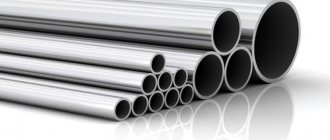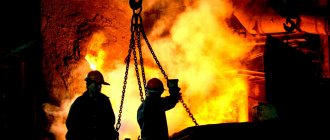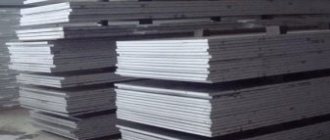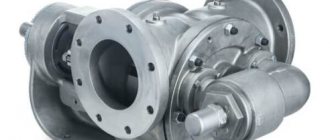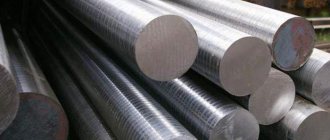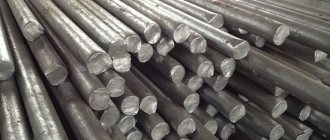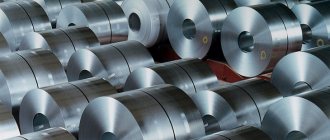What is alloy steel?
Physical properties, such as strength, ductility, fragility, can be increased or decreased several times. Changing the crystal lattice of materials is actively used in metallurgy, as well as in the production of numerous parts and housings for automotive, machine, machine tool and other production, as well as for the creation of building structures and tools. The scope of application is so wide that the alloy began to be produced in large quantities; it is gradually replacing the share of manufactured iron and ordinary steel substances.
Based on the information provided, steel alloying is a metallurgical smelting process during which impurity materials are added to the composition. There are two types of operations:
- Volumetric – when the components fall into the deep structure. Chromium, nickel, etc. are introduced into the melt or charge.
- Surface - during it, diffusion or other spraying occurs, that is, only the top layer is covered.
The process has come into use relatively recently. Experiments began for the first time in 1882. And from the very first sample, the researchers discovered that along with the improvement in physical properties, the degree of machinability was significantly reduced. In simple words, the material simply became difficult to work with. Of course, by now all the additional effects of alloying have been studied, so special GOST standards have been drawn up for different metalworking methods.
What do alloy steel additives mean and their effect on properties
We have already mentioned that some components can be either mandatory or special impurities, depending on their quantity. Different brands may contain:
| Element | Influence |
| Chromium | Significantly protects against corrosion, improves hardness and impact resistance. It is significant that a lot of chromium is added to stainless steel. |
| Nickel | With the addition of this substance, the alloy becomes more viscous and ductile, its fragility decreases, which is very important, for example, before pressure treatment - pressing or stamping. |
| Titanium | Reduces graininess, makes the structure more uniform, and therefore less susceptible to cracks and splits. Additionally, susceptibility to metalworking and rust resistance are improved. |
| Vanadium | As with the introduction of titanium, a less granular shape can be seen. An increase in fluidity and tensile strength is also characteristic. |
| Molybdenum | After it, the hardening process is much more effective, and fragility is reduced, and greater resistance to rust appears. |
| Tungsten | In addition to increasing hardness, it also helps with heat treatment - the grain size does not increase when heated, and during tempering the fragility does not suffer much. |
| Silicon | Its task is to simultaneously increase strength and maintain viscosity levels. But if it is more than 15%, then you can observe an increase in magnetic permeability and resistance to electricity. however, you need to be careful as the steel becomes more brittle. |
| Cobalt | Well protects against rapid destruction under the influence of high temperatures; increases impact resistance |
| Aluminum | Adds scale resistance, that is, in high heat, rapid oxidation does not occur. |
We have listed the main additives that are used during alloying. We will also make a separate table for impurities that cannot be completely removed from the composition.
Compound
Low-alloy steel contains 0.2% carbon and no more than 5% alloying elements (some scientific sources allow the use of additives of no more than 2.5%). Most often, alloying is carried out by adding:
- vanadium - to ensure a uniform structure;
- molybdenum - makes the metal resistant to high temperatures;
- niobium - responsible for increasing strength;
- tungsten, nitrogen - provides increased heat resistance;
- titanium - to increase wear resistance;
- nickel, silicon - gives steel impact resistance and current resistance;
- manganese - makes the metal harder without compromising its ductility;
- cobalt - to increase ductility, strength, and magnetic characteristics.
Low alloy steels - definition, grades, properties
Low-alloy steels include steels with a carbon content of 0.2% and alloying elements with a total amount of up to 2.5%, examples: 09G2, 09G2S, HSND, 15HSND. Such alloys are slightly more expensive than unalloyed carbon alloys, but have a number of advantages over them. Among them, increased ones include yield strength, cold resistance, corrosion resistance, wear resistance, and reduced susceptibility to mechanical aging. The marking of low-alloy steels indicates numbers that indicate the carbon content in hundredths of a percent, and letters indicating which alloying elements were used in the alloy.
Purpose
The high performance characteristics of steels with alloying additives ensure their use in the following areas:
- Construction of pipeline systems for various purposes. The use of steel alloys with additions of chromium, silicon and manganese ensures high strength of structures and products, elasticity, and effective resistance to elastic deformation.
- Production of welded structures in the car, machine tool, automotive, and heavy engineering industries. These alloys are used to produce the bodies of railway and tram cars and agricultural machines.
- Petroleum apparatus engineering. The use of low-alloy steel in this area allows saving metal, reducing the weight of structures, labor costs for manufacturing and installation, and, consequently, cost.
- Construction of engineering structures that are operated under variable dynamic loads, under conditions of daily and seasonal significant temperature changes.
- Production of steam turbines. For these purposes, heat-resistant grades alloyed with molybdenum, chromium + molybdenum, chromium + molybdenum + vanadium are used. Such products are also resistant to significant pneumatic loads.
The most common grade - 09G2S - and its analogues are used in the production of rolled products capable of operating in a wide temperature range - from -70°C to +450°C. Steam boilers, containers and devices operated at high pressure, and welded structures for critical purposes used in the chemical and oil industries and shipbuilding are made from such rolled metal. Grade 09G2S is used in the production of hot-rolled seamless pipes, electric-welded pipes of significant diameters, and containers of significant carrying capacity.
Differences
Alloyed steel differs from unalloyed steel in chemical composition. The first, in addition to iron and carbon, contains a large set of additional components that affect its properties. Carbon (classical) steel contains traces of random impurities that do not significantly affect its properties.
Other differences from conventional carbon alloys:
- resistance to corrosion and aggressive environments;
- sparking of metal if you bring it to the grinding wheel;
- there is low bearing capacity;
- higher production costs.
Properties and Features
The category of low-alloy steels is represented by ferrous metals. Depending on the alloying elements used and their quantity, such a material may have:
- increased resistance to mechanical aging;
- sufficiently high yield strength;
- low threshold of cold brittleness;
- good ductility.
Compared to high-carbon metals, low-alloy steel grades contain a minimum of non-metallic compounds. They also have anti-corrosion and abrasion resistance properties. This material can be easily processed and retains its performance characteristics at sub-zero temperatures. Due to hardening, low-alloy steels become slightly sensitive to notch.
Ball bearing high-quality structural steel GOST 801-78
Regulatory document: high-quality structural alloy ball bearing steel is manufactured in accordance with GOST 801-78.
Classification of ball bearing steel
Depending on the surface quality requirements and depending on further processing:
- for cold machining - OX;
- for hot pressure treatment - exhaust gas;
- for cold heading - ХВ;
- for cold stamping - ХШ.
By shape, size and maximum deviations:
- hot rolled steel circle 40x - GOST 2590-88;
- hot-rolled square - GOST 2591-88;
- square blank - according to current regulatory documents;
- hot rolled strip - GOST 103-76;
- calibrated wheel quality h11 with additional dimensions - GOST 7417-75;
- circle with special surface finishing of quality h11 groups B and G - GOST 14955-77.
According to the condition of the material:
- without heat treatment;
- heat treated.
Grades of ball bearing structural steel
Steel grades: ShKh15, ShKh4, ShKh15 SG, ShKh20 SG.
Designation of steel grades: Ш - bearing, X - alloyed with chromium, number - chromium content, SG - alloyed with silicon and manganese. For example, ball bearing steel and spring steel ShKh15.
Substitutes for some grades of steel:
- ShKh15 - ShKh9, ShKh12, ShKh15 SG;
- ШХ15 SG - ХВГ, ШХ15, ХС, ХВСГ.
Application of ball bearing steel
Manufacturing of parts operating under the influence of concentrated and alternating stresses arising in the contact zone of balls and rollers with the running tracks of rolling bearing rings. ShH15 is especially popular.
Weldability: welded using the KTS method.
Classification of alloy steels
With the development of new technologies and the emergence of different alloy steels, they needed to be classified.
Division by the amount of carbon contained in the alloy:
- High carbon - more than 0.65%.
- Medium carbon - from 0.25% to 0.65%.
- Low carbon - less than 0.25%.
Separation by percentage of alloying additives:
- Low alloyed - up to 5% (according to some sources up to 2.5%).
- Medium alloyed - up to 10%.
- Highly alloyed - 10–50%.
According to their internal structure, alloy steels are:
- Eutectoid - pearlite structure.
- Ledeburite - the presence of primary carbides in the structure.
- Hypoeutectoid - the presence of excess ferrites saturating the composition.
- Hypereutectoid - the presence of secondary carbides in the alloy.
Based on their purpose, these materials can be divided into two large groups:
- Construction - for the manufacture of metal structures that will not be exposed to critical temperatures during subsequent operation.
- Mechanical engineering - used in the manufacture of parts for various mechanisms and housings.
Engineering steels are:
- Cemented - during manufacturing they undergo a process of carburization and then hardening.
- Heat-resistant - medium-carbon steels. They are used in the manufacture of products used in the energy sector.
- Improved - materials that undergo additional hardening. They are used to make parts that are subject to heavy loads.
High carbon alloy steel
Low alloy steels: classification and application
Alloyed steels are those steels that obtain their improved properties due to: - one or more special alloying elements; - higher content of elements such as magnesium and silicon than in conventional carbon steels.
Alloy steels contain manganese, silicon and copper in higher concentrations than normal carbon steels (1.65% manganese; 0.60% silicon and 0.60% copper).
Alloying elements increase the mechanical and technological properties of steels. Typically, alloy steels are divided into three groups according to the total content of alloying elements (not counting carbon): - low-alloy steels - less than 5%; — medium alloy steels – from 5 to 10%; - high-alloy steels - more than 10%.
Low alloy steels
Low alloy steels form a group of steels that exhibit higher mechanical properties compared to conventional carbon steels. This is the result of the addition of alloying elements such as nickel, chromium and molybdenum. For many low-alloy steels, the main function of alloying elements is to increase the hardenability of the steel in order to then optimize the strength and toughness properties through heat treatment. In some cases, however, alloying elements are used to increase the resistance of steel to any specific influences.
Low alloy steels, in turn, are divided into:
- by chemical composition based on the main alloying elements: nickel, chromium-nickel, molybdenum, chromium-molybdenum and the like steels;
- by heat treatment: hardened and tempered (martensitic), normalized and tempered, annealed, and so on;
- by weldability.
Steels can have a huge variety of chemical compositions and, in addition, the same steels can receive different heat treatments. Therefore, there are certain “overlaps” in the classification of low-alloy steels presented above.
For this reason, low-alloy steels are often divided into four large groups, such as:
- low-alloy martensitic (improvable) steels;
- medium-carbon high-strength steels;
- ball bearing steels;
- heat-resistant chrome-molybdenum steels.
Low alloy martensitic steels
Low-alloy martensitic steels are characterized by relatively high strength with a minimum yield strength of 690 MPa and good toughness and ductility, corrosion resistance and weldability. They are also called low-alloy temperable steels, referring to improvement by heat treatment. These steels are used to make plates, sheets, rods, profiles and forged products. They are widely used for the manufacture of pressure vessels, earthmoving and mining equipment, as well as critical elements of large steel structures.
Medium carbon high strength steels
Medium carbon high strength steels are structural and have very high strength. The minimum yield strength of steels of this class reaches 1380 MPa.
GOST 4543-71 divides these alloys into five groups - according to increasing degree of alloying. As the degree of alloying increases, the cross-sectional size of the product at which through hardenability can be achieved increases. The strongest steels from the fifth group are alloyed with 1.2-1.5% chromium; 3.0-3.4% nickel; 0.35-0.45% molybdenum and 0.1-0.2% vanadium.
An example of such steel is chrome-molybdenum steel 30ХМ from the third group according to GOST 4543-71 (analogous to the famous steel 4130, from which bicycle frames are made abroad). The minimum yield strength of 30ХМ steel is 735 MPa, the minimum tensile strength is 930 MPa, and the minimum impact strength KCU is 78 J/cm2.
Ball bearing steels
Ball bearing steels must have high hardness. Therefore, they usually have a carbon content of about 1%. For good hardenability when quenched in oil, these steels have from 0.4 to 1.65% chromium. Sometimes low-alloy bearing steel (0.10-0.20% carbon) is used. In this case, high surface hardness is achieved by cementation.
Chrome-molybdenum heat-resistant steels
Chrome-molybdenum heat-resistant steels contain 0.5-9% chromium, 0.5-1.0% molybdenum and usually less than 0.20% carbon. They are subjected to various heat treatments: normalization with tempering, hardening and tempering, or annealing. These steels are used in oil and gas equipment, the chemical industry, equipment for conventional and nuclear power plants for the manufacture of pipes, heat exchangers and high-pressure vessels.
Explanation of steel markings
To determine the steel grade, a special designation has been developed in accordance with GOST 4543-71. It is based on numbers and letters. The first letter shows which group of steels the alloy belongs to. For example:
- I am chromium-nickel stainless steel;
- A – automatic steel;
- F – stainless steel;
- E – magnetic steel;
- R – high-speed;
- Ш – ball bearing;
- ШХ – ball-bearing chromium steel.
If the letter is missing, this means it belongs to a classic alloy using additives.
The first digit in the marking indicates hundredths of the percentage of carbon content. Next come letters and numbers indicating alloying additives and their content, also in percentages. For example, the marking X5X18N10 should be read as follows: chromium steel containing 0.05% carbon, 18% chromium, 10% nickel. In English, the marking looks different: X5CrNi18-10.
Other examples:
- EX9K15M. Means: magnetic chromium steel, contains 0.09% carbon, 15% cobalt, no more than 1% molybdenum.
- 38ХН3МФ: 0.38% carbon, less than 1% chromium, 3% nickel, molybdenum and vanadium not more than 1%.
The percentage of additives is written in whole numbers, without tenths and hundredths.
At the end of the marking (on the right) there may also be letters: A - high-quality steel, Ш - especially high-quality steel. Other letters indicate the production method: TO (T) - heat-treated, H - cold-worked rolled steel.
Welding alloys
We noted that after adding components, metalworking, including using a welding machine, becomes more difficult. Let's see what the features are.
Low alloy
Recommendations:
- The seam must not be allowed to cool quickly - then microcracks may appear.
- The device must be with reverse polarity and constant voltage.
- Calcium fluoride coated electrodes must be used.
- The process is without interruption, smoothly at an average speed of 20 m/h.
- Voltage – 40 V and current – 80 A.
Medium alloyed
Peculiarities:
- The electrodes should contain less alloying substances than the alloy.
- If the sheet is wider than 5 mm, use argon welding.
- For a gas appliance, use a mixture of acetylene and oxygen.
High alloy
- Thermal capture of the material is minimal.
- Electrodes with calcium fluoride coating.
- Do not use gas welding.
In the article we told you everything about alloy steel: what it means, the features of its production, properties and composition. We hope that the information was informative for you.
Application of metal
Low alloy steels are used in various industries. Application area:
- Manufacturing of lightweight metal structures.
- Housings for household appliances.
- Parts for industrial equipment.
- Cutting tools.
Due to the high price of such materials, they are used in cases where analogues cannot cope with the tasks.
Metal construction
Weldability of steel
| № | Symbols of weldability groups adopted in the tables |
| 1 | I — welded without restrictions; |
| 1* | I* - welded without restrictions (except for chemically and thermally treated parts); |
| 2 | II - limited weldability; |
| 3 | III - difficult to weld; |
| 4 | IV - not applicable for welded structures. |
| Symbols of welding methods adopted in the tables: | |
| Legend | Description of welding method |
| RD | Manual arc welding with coated electrodes; |
| GLAD | Manual argon arc welding with non-consumable electrode |
| MP | Mechanized welding with a consumable electrode in a carbon dioxide environment; |
| AF | Automatic submerged arc welding |
| ES | Electroslag welding; |
| EL | Electron beam welding |
| CT | contact welding |
| That. | Heat treatment; |
| P. | Heating |
| MKK | Intercrystalline corrosion. |
Difference between low alloy steel and high alloy steel
The main difference between low alloy steel and high alloy steel is that low alloy steels contain less than 0.25% alloying element, whereas high alloy steels have more than 10% alloying element.
In addition to dividing into low-alloy and high-alloy steel, it is also divided according to the degree of alloying into medium-alloy. In this steel, the amount of alloying elements ranges from 2.5 to 10%)
An alloy is a mixture of two or more elements. It is produced by mixing a metal with some other elements (metals or non-metals or both) to produce a material that has improved properties over the original metal. Low alloy steel and high alloy steel are two types of iron alloys with alloying elements.
The most popular alloying elements in these steels are: nickel (Ni), copper (Cu), titanium (Ti) and vanadium (V), nitrogen (N), etc.
What is low alloy steel?
Low alloy steel is a type of alloy steel whose properties are improved compared to carbon steel. For example, this alloy has better mechanical properties and greater corrosion resistance than carbon steel. The carbon content of low alloy steel is less than 0.2%. The most common alloying elements in this steel are: Nickel (Ni), Chromium (Cr), Molybdenum (Mo), Tungsten (V), Boron (B), Tungsten (W) and Copper (Cu).
In most cases, the manufacturing process of these alloy steels includes heat treatment and tempering (for normalization). But now, there is a tendency to harden and temper. In addition, almost all low alloy steel materials are weldable. However, the material sometimes requires treatment before or after welding (to avoid cracking).
Some advantages of low alloy steel:
- Yield strength is higher
- High tensile strength
- Higher resistance to oxidation and corrosion
- Low cold brittleness threshold
This material is used in industry, but up to a maximum temperature of 580 °C. If the temperature is higher than 580 °C, this material is not suitable due to lack of sufficient oxidation resistance to cope with high temperatures.
What is high alloy steel?
High alloy steel is a type of alloy steel that contains more than 10% alloying elements. Unlike low alloy steel, the alloying elements for high alloy steel are chromium (Cr) and nickel (Ni). The most famous example of this steel is stainless steel.
Chromium provides steel with a thin oxide layer on the surface of the steel. This is called the hidden layer because this layer retards corrosion of the metal. In addition, manufacturers typically add large amounts of carbon and manganese to give the steel its austenitic character. In addition, this material is more expensive than low alloy steel.
What is the difference between low alloy steel and high alloy steel?
Both low-alloy and high-alloy steel have improved properties than carbon steel. However, the key difference between low alloy steel and high alloy steel is that low alloy steels contain less than 0.25% alloying elements, while high alloy steels contain more than 10% alloying elements. In the chemical composition, low alloy steel contains iron, carbon (less than 0.2%) and other alloying elements such as Nickel (Ni), Chromium (Cr), Molybdenum (Mo), Tungsten (V), Boron (B), Tungsten ( W) and Copper (Cu), while high alloy steel contains iron, chromium, nickel, carbon, manganese, etc.
Carbon quality structural steel
Regulatory document: high-quality structural carbon steel is manufactured in accordance with GOST 1050-88, GOST 1051-73.
Carbon steel is a steel that does not contain alloying elements, but contains carbon in varying concentrations: up to 0.25% - low-carbon steel, 0.24-0.6% medium-carbon steel, more than 0.6 - high-carbon steel.
Classification of carbon steels
By quality
- ordinary quality;
- improved quality;
- high quality.
By purpose, ordinary quality steel:
- A - supplied according to mechanical properties, used in products subjected to hot processing (welding, forging, etc.), which can change the regulated mechanical properties;
- B - supplied by chemical composition, used for parts subjected to processing that can change the regulated mechanical properties, while their level, in addition to the processing conditions, is determined by the chemical. composition;
- B - supplied according to mechanical properties and chemical composition for parts to be welded.
According to the degree of deoxidation:
- boiling - kp;
- semi-calm - ps;
- mild steel without heat treatment - sp.
According to the chemical composition for high-quality steel:
- I - with normal manganese content (Mn 0.80%);
- II - with a high content of manganese (Mn 1.2%) - G.
Grades of quality structural carbon steel
Carbon steel of ordinary quality: St0, St1kp, St1ps, St1sp, St2kp, St2ps, St2sp, StZkp, StZps, StZsp, StZGps, StZGsp, St4kp, St4ps, St4sp, St5ps, St5sp, St5Gps, Stbps, Stbsp.
Carbon quality steel: 08, 10, 15, 20, 25, 30, 35, 40, 45, 50, 55, 58, 60 - machine steel; A12, A20, A30 - automatic steel.
Designation of the steel grade: “St” - steel, the numbers following it are the conditional number of the grade depending on the chemical composition, then the degree of deoxidation (“kp”, “ps”, “sp”) is indicated.
Substitutes for some grades of steel:
- St20 - St15, 25;
- St35 - St30, 40, 35G;
- St45 - 40X, St50, 50G2.
Use of high-quality structural carbon steel
| steel grade | Application area |
| 08kp, 10 | Parts produced by cold stamping and cold heading, tubes, gaskets, fasteners. Cemented and cyanidated parts that do not require high core strength. |
| 15, 20 | Lightly loaded parts: rollers, pins, stops, copiers, axles, gears. Thin parts subject to abrasion: levers, hooks, traverses, liners, bolts, couplers, etc. |
| 30, 35 | Parts experiencing low stress: axles, spindles, sprockets, rods, shafts, etc. |
| 20k | Boiler steel. |
| 40, 45 | Parts with increased strength: crankshafts, connecting rods, ring gears, camshafts, flywheels, gears, studs, ratchets, etc. |
| 50, 55 | Gears, rolling rolls, rods, bandages, shafts, lightly loaded springs, etc. |
| 60 | Parts with high strength and elastic properties: rolling rolls, eccentrics, spindles, spring rings, clutch springs and discs, shock absorber springs. |
| A12, A20, A30 | Irrelevant mass-produced parts produced on automatic machines. |
Weldability: good for boiler steels and steel grades St08-St35; difficult for steel St45; automatic steels are not used for welding.
Welding
To connect parts made of low-alloy steel using welding, you need to take into account several nuances:
- Make vertical, ceiling seams.
- The welding rod must have a cross-section of at least 4 mm.
- To reduce the cooling rate of the metal, it is necessary to make butt or side welds.
- When welding workpieces with a thickness not exceeding 6 mm, only one pass is required.
- To give the connection high ductility, you need to use E42A electrodes.
- If the metal contains a small amount of carbon, it is necessary to use electrodes coated with fluorine and calcium.
To carry out welding work, it is necessary to use a special additive Sv-10G2.
Low-alloy steels have increased technical parameters due to the addition of additional components to the composition. They are used in those areas of industry where it is necessary to use parts and metal structures of high strength and wear resistance. To connect individual parts, you need to take into account a number of nuances of using welding equipment.
Sources
- https://www.rocta.ru/info/legirovannaya-stal-chto-ehto-takoe-marki-sostav-vidy-i-primenenie/
- https://pressadv.ru/stali/stal-konstrukcionnaya-nizkolegirovannaya.html
- https://MetalListen.ru/stali/nizkolegirovannaya-stal-marki.html
- https://spb-stal.ru/stati/nizkolegirovannaya-stal-osnovnye-kharakteristiki/
- https://co-vally.ru/instrumenty/chto-oznachaet-nizkolegirovannaya-stal.html
- https://elton-zoloto.ru/metally-i-splavy/nizkolegirovannaja-stal-chto-jeto.html

